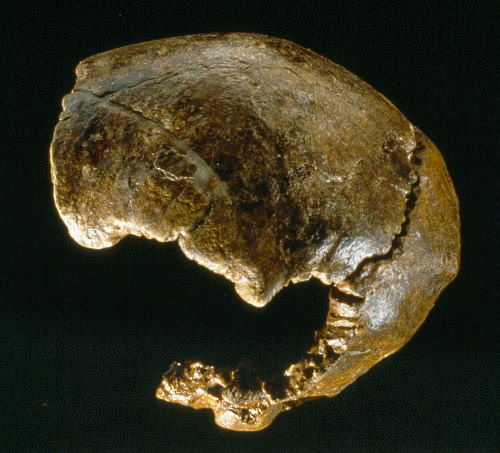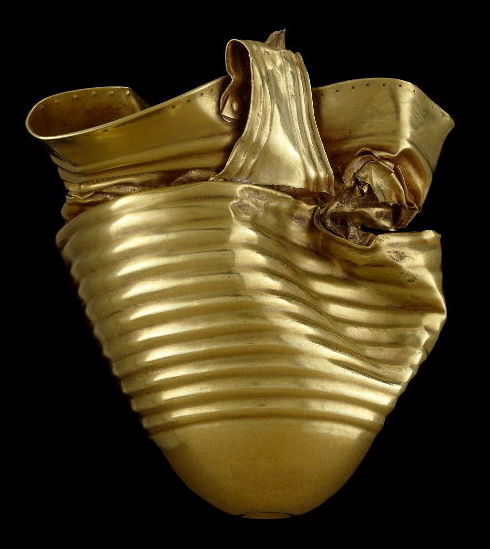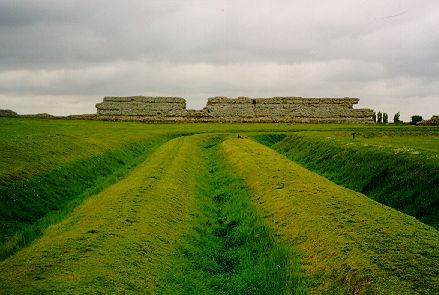Lyn Palmer
Introduction
Some of these finds and sites were never really ‘lost’, having always been visible; some have been chance discoveries, others have been uncovered through excavation. All though, are in some way ‘great’ in the archaeology of Kent.
The list is, of course, subjective, since everyone will have their own ‘greatest’!
There are other great heritage sites in Kent which are iconic in a different way; they are well-known and often visited - for example, Canterbury Cathedral and Leeds Castle, but they have not been included here.
Swanscombe Skull
The Second oldest human remains in Britain
The skull is formed of 3 pieces which fit together to form the rounded top and back; the facial portion is missing. The pieces were found at Barnfield Pit, a gravel quarry in Swanscombe, north Kent, one of the richest Palaeolithic (old stone age) sites in the world. Incredibly, the pieces were found some 20 years apart, between 1935 and 1955. They are around 400,000 years old and are the second oldest human remains found in Britain. The Swanscombe human, probably female, did not look or behave like a modern human though. The skull is thought to belong to an ancestral form of the Neanderthals, perhaps an early human known as Homo Heidelbergensis. When she was alive, rhino, hippo and elephant roamed the landscape.
The skull is now kept at the Natural History Museum, but replicas are on display in Swanscombe Leisure Centre and Dartford Museum. The find spot and surrounding area is within Swanscombe Heritage Park, now a national nature reserve, with information boards and a heritage trail.

Image: The Swanscombe Skull (copyright Natural History Museum)
Southfleet Road Elephant
Butchery, 400,000 years ago
The well-preserved skeleton of an extinct straight-tusked Elephant (Palaeoloxodon antiquus) was found during excavation in advance of the Channel Tunnel Rail Link at Ebbsfleet. It had been preserved where it had died, in the muddy sediment of what was once a lake edge. The bones were surrounded by flint tools, lying just where they had been left c.400,000 years ago. It is likely that the tools were made on the site to butcher the carcass, as some had use-marks on them. Evidence such as this of early man’s survival strategy is very rare, although it is not certain whether the animal was deliberately driven into the boggy mud to trap and kill it, or whether it was already stuck there, perhaps even near death when people chanced upon it. At over twice the height of a man, it would have been a fearsome adversary.
Coldrum long barrow
Probably one of the earliest long barrows in Britain
Coldrum is the best preserved of the 'Medway Megaliths'. It is one of the group of megalithic burial mounds which sit on the west bank of the River Medway. Unlike the others, it still has its covering mound and kerb stones, as well as much of its stone chamber, intact. It was one of the first monuments of this type built in England, around 6000 years ago.
The site is under the care of the National Trust; a small car park is situated about 500m away for visitors use. Click on the link above for more information.

Image: Coldrum long barrow
Dover Bronze Age Boat
The oldest seagoing craft in the world
Discovered in 1992 when a new 6 m deep underpass was being built in Dover, the Dover Boat is one of the most complete prehistoric vessels discovered in Britain. In use around 3600 years ago, it would have been capable of cross-Channel voyages as well as plying along the coast of England. Its surviving length is 9 m, although its complete extent is unknown as part is still buried. The wood had survived due to waterlogged conditions, but had the consistency of a wet biscuit when uncovered. It has been conserved by replacing the moisture with a wax substance known as PEG.
It is now housed in an award-winning gallery about the Bronze Age, within Dover Museum.
The Ringlemere Cup
A prehistoric gold cup, one of only two in Britain
In 2001 a metal detectorist searching a field near Ringlemere, east Kent, uncovered a gold cup. The cup was buckled inwards, squashed by the ploughshare which had caught it. It had been deliberately buried in a mound, built within an earlier henge, and dates from c.1800-1600BC. The henge, probably built in the 4th millennium BC, was a special place set aside for ceremonial use. As the millennia passed, the area remained so; Bronze Age burial mounds (barrows) clustered nearby and Anglo-Saxon burials were made some two and a half thousand years after this.
The cup is about 11cm high, with a handle on one side. It is remarkably similar to a gold cup from Rillaton in Cornwall, which was found in 1837. The shape of the gold Cornish and Kentish cups is reflected in cups fashioned in other materials such as silver, amber and shale from north-western Europe. Both are now in the British Museum.

Image: The Ringlemere Cup (copyright The British Museum)
Lullingstone Roman Villa
Cultured Romano-British and early evidence for Christianity
This site is remarkable for its mosaics and early Christian iconography, uncovered by Colonel Meates from the late 1940s to the early 1960s. The villa started life around AD100 as a modest building and was added to and altered over more than two centuries.
By the beginning of the fourth century, brightly coloured mosaics covered the floors of the main rooms. The dining room mosaic was an abstract design of interlocking patterns with a central panel portraying the four seasons as figures, surrounding Bellerophon riding Pegasus, the winged horse. A semicircular room (an apse) was later added to this room; the mosaic in this reveals an appreciation of, and ease with, classical culture. A Latin text from Virgil was meant to be read and understood by both by villa owners and guests, just as in the rest of the Roman Empire.
Wall paintings created at the end of the fourth century collapsed into a cellar when the villa was finally abandoned. They show figures, known as orantes, standing with arms outstretched before them, in the manner of early Christian prayer. The Chi-Rho monogram (the first two letters in the Greek spelling of the word Christ) is also repeatedly painted. The room which contained this unique evidence is thought to have been a house church
The Villa is run by English Heritage.
Springhead Roman religious centre
The most fully-explored Roman sanctuary and town
Vagniacis, as the Romans knew it, is now the most fully-explored site of its kind in Britain. It was first investigated in the 19th century, more fully by the Gravesend Historical Society between the 1950’s and ‘80’s, and most recently in advance of the Channel Tunnel Rail Link. The site was on Watling Street, with travellers from Canterbury to London passing through.
It developed as a major religious centre focussing around natural springs during the first and second centuries AD, although its origins were during the pre-Roman Iron Age, when a ceremonial way was created. The Romans constructed at least seven temples near the pool below the springs, and many votive offerings have been found during excavation.
A settlement grew up around the site, catering to the needs of visitors, with shops, workshops and houses. The dead were catered for too; over 500 burials were found in a cemetery to the south and a walled cemetery containing stone sarcophagi lies to the south-east.
Richborough Fort & the Quadrifons Arch
The Roman gateway to Europe
After the Roman invasion of AD43, the army developed Rutupiae, as it became known, as a military base. Sited on the edge of a channel between Thanet and ‘mainland’ Kent, it provided sheltered mooring with the beachhead protected by a large defensive ditch. The garrison expanded over several decades, controlling the crossing to Gaul (France). Around AD80-90 a huge marble-clad arch was built overlooking the harbour. At 25m high and gleaming white, it must have been an impressive sight greeting new arrivals to Britain, especially given that its construction probably celebrated the country’s conquest.
A large town covering 20 hectares developed during the second and third centuries, including an amphitheatre and temples. In the third century the arch, now ruinous, became a watchtower. A new fort was built c. AD275, one of a series along the south-east coast designed to guard against Saxon incursions. Rutupiae was one of the last places in Britain to be supplied with coinage, as it remained a key base until the withdrawal of troops in AD406.

Image: Richborough Roman Fort
The Pharos, Dover
A Roman lighthouse, still gazing out to sea
Originally, a pair of lighthouses stood on the top of the hills at either side of the entrance to Roman Dover. That on the western side has now almost disappeared but the eastern example still stands to a magnificent 19 metres, its original height being estimated at 24 metres. It was built of flint rubble with tiles separating different stages, stepped inwards as it rose. Of the remaining five stages the lower four are Roman, whilst the fifth is a medieval addition. The inner chamber is around 4.3 metres square, the outside is octagonal. The pharos can be visited within the grounds of Dover Castle.
Dover was a major Roman port from the 2nd century AD onwards, a key entry point into Britain opposite Boulogne, and a base for the 'Classis Britannica' – the Roman fleet. Outside the navy’s fort, buildings grew up; amongst these was a mansio, providing accommodation for visiting officials. Part of this is now known as the ‘Roman Painted House’, as a series of wall paintings was revealed during excavation. Built around AD200, it was demolished some 70 years later when a larger fort was built. Three rooms survived buried under the new ramparts, and parts of 28 painted wall plaster panels still exist, relating to Bacchus, the god of wine. The House can be visited.
The Ebbsfleet Watermill
Rare Anglo-Saxon tidal mill
Discovered in advance of building the new Ebbsfleet railway station, the timbers of this structure were almost perfectly preserved. They have been dated to around AD 700, and are amongst the earliest examples of their kind found in Britain, although it is possible that the structure may have been built slightly later with reused timber. Two enclosed funnels, known as ‘penstocks’, directed jets of water onto a pair of horizontal wheels with paddles. The mill was located in the tidal zone of the River Ebbsfleet and it is likely that the ebb and flow of the waters were harnessed.

Image: The Ebbsfleet Anglo-Saxon watermill
The Kingston Brooch
Beautiful and plentiful Anglo-Saxon ornaments
Kent has a huge number of Anglo-Saxon cemeteries. The graves which have been explored, many in the 18th and 19th centuries, have yielded an enormous quantity of metal and glass objects, including many brooches. The evolution of brooch styles has helped archaeologists piece together the story of Saxon settlers.
The Kingston brooch is the largest and finest of its type and symbolises the beauty and exquisite workmanship of Anglo-Saxon grave goods. It was excavated in 1771 on the Barham Downs near Canterbury, from a large mound containing the burial of a small woman. Fashioned of gold, with settings of garnet, blue glass and shell, its quality and condition are superb - even the back of the brooch is fabulous. It has been dated to the 7th century. The brooch’s quality demonstrates the high Ievel of skill of the craftsmen around Faversham where the brooch originated – a truly Kentish masterpiece. It is now on display in the World Museum, Liverpool.
